by Les Harrison | Oct 20, 2014
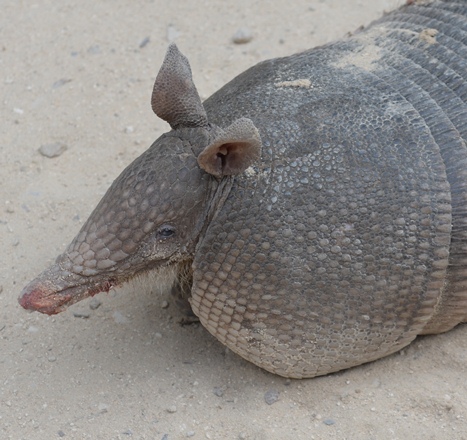
Appearing clumsy and bumbling at first glance, these exotic invaders quickly damage landscapes in search of tasty insects.
It can be pretty discouraging to step out one morning to find a lawn pock-marked like the lunar surface. Stunned surprise then anger is usually the owner’s response.
The offender is not the neighborhood teenager with a reputation for inappropriate practical jokes. The offender is most likely an armadillo, sometimes identified as a Florida-speed-bump or a Possum-on-the-half-shell.
Armadillos eat mostly adult insects and their larvae. They incessantly dig holes in lawns and landscapes in their search for food, many times uprooting plants and turf in their food search. Their holes are approximately one to three inches deep and three to five inches wide.
Using insecticides to decrease the armadillo food supply is not guaranteed, but may help reduce the digging. In cases where there is a large, and always ravenous, armadillo population this reduction of food may increase digging activity as they search more diligently for a smaller food supply.
Another consideration is all chemical treatments have to be re-applied on a permanent basis for impact. Always read and follow label instructions for safe use of insecticides.
To add insult to landscape injury, armadillos burrow under driveways, foundations and patios potentially causing structural damage. Additionally, their burrows in pastures pose a potential leg-injury hazard to livestock.
Burrows openings are approximately seven to eight inches in diameter, about the size of a one-gallon plastic jug, and up to 15 feet in length. The sandy soil is piled up right outside the burrow entrance. Armadillos usually rest in a deep burrow during the day and are most active after dark.
Because armadillos are nocturnal, trapping techniques designed to capture them as they emerge from their burrows should be applied late in the afternoon and checked several hours after darkness. Fencing is another potential option to discourage the presence of armadillos.
Several live-trapping techniques can be used to capture armadillos as they exit of their burrows. One method is to firmly insert a six-inch diameter PVC pipe into the entrance of an active burrow. Adult armadillos will get stuck in the pipe as they try to exit. Another option involves a nylon throw-net staked down to cover the burrow entrance. Armadillos will get tangled in the net as they emerge.
Some can be discouraged from returning to their burrows by filling the hole with a mixture of dirt and mothballs after they have departed for a night of foraging. Laying chicken-wire along a patio, driveway or house foundation will discourage burrowing.
Armadillos can also be trapped using a raccoon-size metal trap, available from local pest control, feed and home improvement stores. These animals are more likely to enter a cage trap with leaf litter or soil placed over the wire bottom.
Suggested baits for the trap are live earthworms or meal worms in surrounding soil placed in hanging bags made of old nylon stockings. Overripe or spoiled fruit which will attract insects may be used as bait. Poison baits are illegal and no chemical repellents or fumigants are registered for use in Florida.
Relocating problem animals is not recommended because it only transfers the problem elsewhere and can spread disease.
To learn more about controlling armadillos contact your local UF/IFAS Extension Office or read Baiting the Nine-banded Armadillo at http://edis.ifas.ufl.edu/uw362
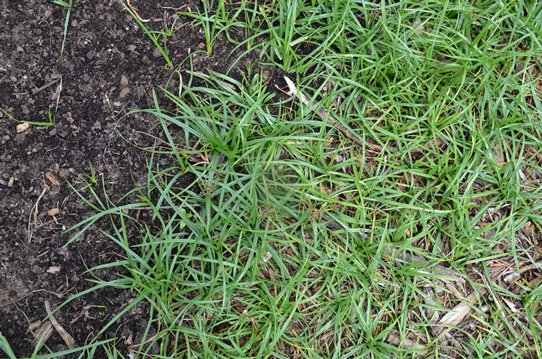
by Les Harrison | May 6, 2014

Purple Nut Sedge aggressively moves into any sunny open space and crowds out competitors.
The spring season in panhandle Florida is colorful. Every location from frequently manicured gardens to untended fields and pastures are exploding with hues and tones pleasing to the eye.
These heralds of the warmer weather to come are trailed by the warm season’s greenery which fills in the gaps between blooms. The consistent and ample rains have assured the continuance of a bright and pleasing landscape backed by countless shades and textures of green.
The adequate moisture has also assured the aggressive growth of an individually small, but collectively gigantic, weed which plagues every member of humanity associated with attempting to cultivate plants.
Purple nut sedge, Cyprus rotundus, has emerged en mass from every possible sunny location with soil. This native plant is a rapidly spreading perennial which will take every opportunity to colonize new locations.
The identifier purple is in the name because there is a purple-tinged section of this sedge where it emerges from the ground. The plant is sometimes referred to as purple nut grass because of its long narrow leaves and its erect growth pattern originate from a nutlike basal bulb.
There are other sedges in north Florida, but only yellow nut sedge is identified by a specific color. It is sometimes called chufa and is a popular feed for wild turkeys and turkey hunters.
The dark green, smooth leaves blend in easily with many turf grasses. Beneath the soil’s surface and out of sight, the root system grows in every direction.
Purple nut sedge’s roots are a series of spreading rhizomes and tubers or bulbs identified as nutlets. Each nutlet sprouts a new bunch of grass-like leaves and continues growing the rhizomes.
The densely population of this sedge quickly crowds out most other plants, but most especially turf and forage grasses. It can reach a height of 18 inches on its triangle shaped stem.
The root system’s design assures this plants survival and continued success. If pulled, the rhizomes break off leaving a large number of nutlets to develop and emerge at a later date.
If plowed or tilled, the nutlets are detached and spread to new and inviting locations. Many times nutlets lodge in tillage equipment only to shake loose and deposited in un-colonized locations.
Most herbicides have little on this sedge’s hardy root system. Selected pre-emergent herbicides will prevent many of the nutlets from germinating in spring.
North Florida’s sandier soils provide an ideal growing environment for purple nut sedge. The occasional periods of water saturation from storms do not deter this plant’s rapid and growth expansion to new areas, but it will not tolerate heavy shade.
Purple nut sedge’s extreme competitive nature is a heavy consumer of plant nutrients and robs rivals of important compounds necessary for their survival. Additionally, it produces an allelopathic substance which is toxic to some plants.
Purple nut sedge is found in many locales in North America where the environment is hospitable to its growth. The lush green leaves and touch of purple signify work for anyone who is maintaining a lawn or garden.
To learn more about purple nut sedge in north Florida contact your local UF/IFAS County Extension Office and read this informative publication on purple nutsedge.
by Les Harrison | Apr 8, 2014
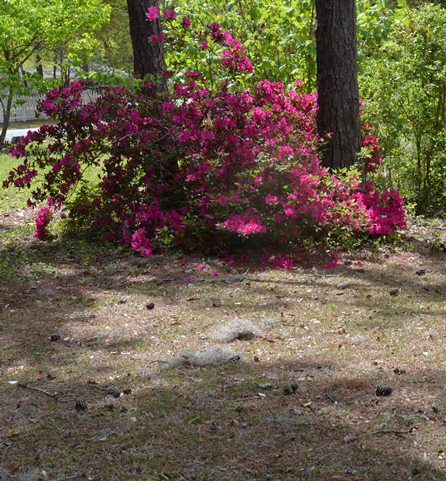
While the azaleas may be blooming, most north Florida Lawns still need some work to be ready for the growing season.
Spring is officially here, so this means it is time to get the lawn in shape for another growing season in north Florida. The first step is to develop an action plan which sets the path to achieving turf success.
A good starting point is mowing the lawn to get any leaves removed and trim any weeds which have emerged. Empty the bagged clipping in a compost pile for later use.
Shaded areas under trees must be treated differently since grass will not grow in those areas. Just leave the natural tree leaf mulch there and add additional mulch as needed.
If there are marginally shaded areas where turf is preferred, spring is a good time to plant some grass plugs. All southern turf grasses prefer full sun, but a few St. Augustine cultivars such as ‘Seville’, ‘Delmar’, and ‘Captiva’ will tolerate some shade.
Trying some plugs of ‘Seville’ St. Augustine is a low-cost way of determining if there is enough sunlight to grow grass. The plugs are available at local garden centers.
If the plugs don’t take hold and spread, then there is not enough sunlight. Use groundcovers, mulches, or other plantings in these shaded areas.
Before mowing, use a ruler to set the cutting level. Try to never remove more than one-third the length of the grass blade at any one mowing.
Sharpen the mower blades after every four to eight hours of mowing so a ragged cut is avoided. Maintain St. Augustine grass at about three inches tall and centipede at about one and one-half inches.
Most of the weeds currently in panhandle Florida lawns are winter annuals. They are flowering and will soon go to seed, then die as the weather gets hotter.
It is difficult to kill these winter annuals at this mature stage, so applying herbicide now is pointless. The best option is to keep the weeds mown so they do not produce as many seed and reemerge next year. Also, apply a pre-emergent herbicide in October 2014 to minimize 2015’s spring weeds.
Now is the time to put out a pre-emergent herbicide for some of the summer weeds, particularly chamberbitter.
Unless a soil test indicates a need for phosphorus, the best fertilizers to use on lawns will be missing this nutrient. The commonly available 15-0-15 fertilizers should also have half of the nitrogen (7.5%) in a slow-release form.
Many local retailers have these 15-0-15 fertilizers with and without herbicide. Generally speaking apply the 15-0-15 fertilizer without herbicide. Below is a table of recommended fertilizer application rates based on typical lawn square footage.
Table 2. Recommended application rates for turfgrass fertilizers to Florida lawns: 15–30 percent slow-release nitrogen. From Publication #ENH979
| Use this table to match the size of your lawn to the percentage of nitrogen (N) in your fertilizer to find the amount of fertilizer you need to apply. If you have a bahiagrass lawn, apply this amount of fertilizer about four times a year no matter where you live in the state. For centipedegrass, apply about twice a year in north Florida . For St. Augustinegrass or zoysiagrass, apply about four to six times a year in north Florida. UF/IFAS recommends soil testing for phosphorus content before any P fertilizer is applied. |
| |
6% N |
10% N |
12% N |
15% N |
16% N |
23% N |
27% N |
| 1,000 ft2 |
8.25 lbs |
5 lbs |
4.25 lbs |
3.25 lbs |
3 lbs |
2.25 lbs |
2 lbs |
| 1,100 ft2 |
9.25 lbs |
5.5 lbs |
4.75 lbs |
3.5 lbs |
3.5 lbs |
2.5 lbs |
2 lbs |
| 1,200 ft2 |
10 lbs |
6 lbs |
5.25 lbs |
4 lbs |
3.75 lbs |
2.5 lbs |
2.25 lbs |
| 1,300 ft2 |
11 lbs |
6.5 lbs |
5.75 lbs |
4.25 lbs |
4 lbs |
2.75 lbs |
2.5 lbs |
| 1,400 ft2 |
11.75 lbs |
7 lbs |
6.25 lbs |
4.5 lbs |
4.5 lbs |
3 lbs |
2.5 lbs |
| 1,500 ft2 |
12.5 lbs |
7.5 lbs |
6.75 lbs |
5 lbs |
4.75 lbs |
3.25 lbs |
2.75 lbs |
| 2,000 ft2 |
16.75 lbs |
10 lbs |
8.5 lbs |
6.5 lbs |
6 lbs |
4.5 lbs |
4 lbs |
| 2,500 ft2 |
20.75 lbs |
12.5 lbs |
10.5 lbs |
8.25 lbs |
7.75 lbs |
5.5 lbs |
4.75 lbs |
| 3,000 ft2 |
25 lbs |
15 lbs |
12.75 lbs |
9.75 lbs |
9 lbs |
6.5 lbs |
6 lbs |
| 3,500 ft2 |
29 lbs |
17.5 lbs |
15 lbs |
11.5 lbs |
10.75 lbs |
7.75 lbs |
6.75 lbs |
| 4,000 ft2 |
33 lbs |
20 lbs |
17 lbs |
13 lbs |
12 lbs |
9 lbs |
8 lbs |
| 4,500 ft2 |
37 lbs |
22.5 lbs |
19 lbs |
14.75 lbs |
13.75 lbs |
10 lbs |
8.75 lbs |
| 5,000 ft2 |
41 lbs |
25 lbs |
21.25 lbs |
16.5 lbs |
15.5 lbs |
11 lbs |
9.5 lbs |
| *These recommendations assume use of a properly calibrated spreader. See www.yourfloridalawn.ifas.ufl.edu for instructions on calibrating your spreader. |
If the soil is too compacted, too wet, too dry, or has nematodes, certain weeds may grow better in those conditions than does your lawn grass. Take the time to identify why the grass is not growing well.
Rain has provided enough water so far this spring, but this could change at any moment. However, do not water unless it is needed.
Only water when about thirty percent of the lawn wilts, turning dull grayish color as the leaf blades roll inward. At that time water deeply, applying about one-half inch of water as measured in cans placed in the sprinkler pattern.
To learn more about proper turf care in north Florida contact your local UF/IFAS County Extension Office.
by Les Harrison | Mar 4, 2014
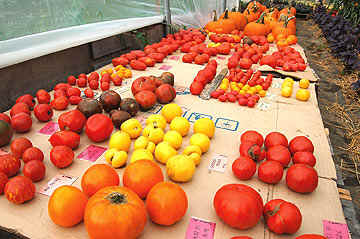
An assortment of Heirloom Tomatoes. Image Credit Dan Culbert
Thursday night’s temperatures have confirmed the winter of 2014 is not over. This year’s cold days and freezing nights have taken a toll on power bills, auto batteries, and the mosquitoes.
Still there is indication that spring will soon be coming. The most tangible evidence is arriving in north Florida mailboxes almost daily.
Garden catalogs from every part of the nation are finding their way into many area homes. Their pages promise the buyer the potential for legendary success and the envy of their friends and neighbors.
After all, who can resist the full color beauty of giant flowers, large luscious fruit and vegetables which are sure to win a prize at the fair? There is not a runt, reject or cull in all the pages of these publications offering the mortal version of horticultural heaven.
Before ordering, the would-be gardener should consider several factors to increase the likelihood of a positive gardening experience. A failure will waste not only funds, but also much time and hard work and may introduce a long-term problem or two.
Cultivar selection for a tree, shrub, vegetable or fruit is critically important to producing the desired results. While a specific plant cultivar may grow and produce in one environment, it may not do so in all situations.
A common example of this problem is grape vines offered. Only muscadine grapes will grow and produce locally because Pierce’s disease kills other varieties.
Carefully examine the growing zones recommended by the catalog for specific cultivars. Check with fellow gardeners and the UF/IFAS Extension Office to see if they have any information or experience with any cultivars under consideration.
Heirloom varieties are especially sensitive to the variances in growing conditions. While they offer unusual and sometimes unique taste and culinary traits or landscaping characteristics, these antique varieties can be a challenge to grow.
Their genetic potential can make a consistent yield, especially for the novice growers, a real effort. Also, as an open pollinator variety, the results can be inconsistent.
Another question for the catalog company customer is new or untried plants varieties. Some of these plants are patented and few or no trials have been performed with them in north Florida’s growing zone.
Caution should be used when ordering these seed or plants. Being the first in North Florida to cultivate a new variety may require a large commitment of time and resources, and may produce only a large disappointment.
Check with fellow gardeners, local nurseries and your UF/IFAS Extension Office for available information on these new or patented varieties. It may save much wasted motion.
Lastly, be sure the plant or seeds under consideration do not have the potential as exotic invasive pests. As hard as this may be to believe, this does occur.
Some catalog vendors will advise buyers in the ordering instructions or at the time of ordering. Either way, the purchaser should check to verify the plant ordered does not have the potential to escape control and damage the environment.
by Les Harrison | Dec 2, 2013
Tarzan used them as a superhighway through the trees in every adventure created by Edgar Rice Burroughs. Villains and scoundrels alike fell prey to the ape-man and his horde of avenging simians descending on vines from the trees.
Great fiction, but removed from the reality of present day panhandle Florida. This is especially true about the vines which are impossible to use as a propulsion system and in many cases are exotic invaders.
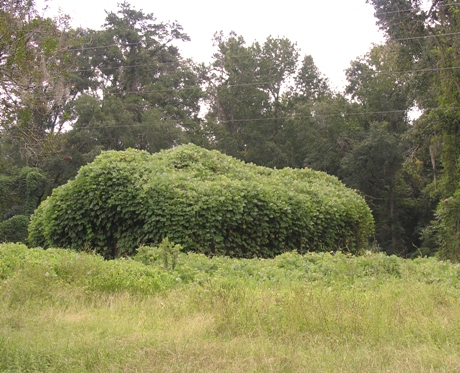
Kudzu Vines Covering native vegetation – Image Credit Les Harrison UF IFAS
The most infamous is Kudzu (Pueraria montana), sometimes known as the weed that ate the south. It was introduced into the United States at the Philadelphia Centennial Exposition in 1876.
By 1900 kudzu was available by mail order as inexpensive livestock forage, and later sold by the USDA as an erosion control. The vigorous nature of the plant allowed it easily to escape into the wild.
It now exists in impenetrable tangles as large as 100 acres killing trees, covering structures, and smothering native plants. Kudzu is an aggressive leguminous vine capable of growing one foot per day. It can easily grow 60 feet in a single growing season.
It establishes roots sporadically as it covers an area, layering vines and foliage on top of each other. One key to this plant’s efficiency is its ability to orient each leaf so that the maximum amount of sunlight possible is absorbed. This multi-directional orientation of leaves also poses special problems with sufficiently wetting the top sides of foliage with herbicide.
Special effort is necessary to control kudzu. Older, well established plants are harder to control and completely eradicate. Follow-up spot treatments can require five to ten years in extreme cases. For easiest access, it is best to evaluate kudzu problems in winter when vines and foliage are withered.
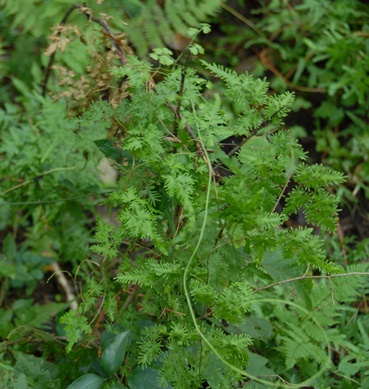
Japanese Climbing Fern – Image Credit Les Harrison UF IFAS
Japanese Climbing Fern (Lygodium japonicum) is another aggressive exotic invasive, but not as commonly recognized as Kudzu. It is presently the only non-native invasive fern in the Florida.
Japanese climbing fern is a delicate looking perennial climbing vine. It is capable of forming a dense mat-like thatch capable of covering trees and shrubs. Initially, it was introduced from Japan as an ornamental.
This fern reproduces and spreads readily by wind-blown spores. Animals, equipment, and even people who move through an area with climbing ferns are very likely to pick up spores and move them to other locations.
It is scattered throughout the lower portions of Alabama, Georgia, Louisiana, South Carolina, and much of Florida, including panhandle. Planting or cultivation of this vine for ornamental purposes is prohibited by statute.
Both vines have many negative attributes. Among these are crowding out native vegetation, harboring destructive insects and diseases, and providing a fire bridge to the crown of unlucky trees.
Adequate control of both exotic vines has been achieved with multiple applications of herbicides. As with most invasive plants, repeated and correctly timed treatments are likely to be necessary.
Contact your local UF IFAS Extension office for more information






